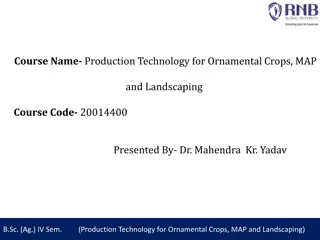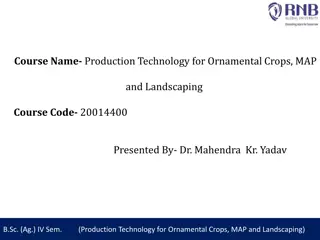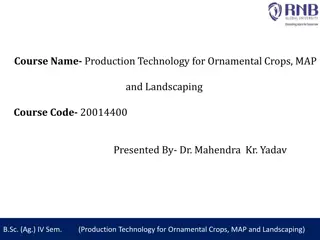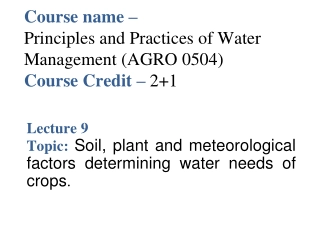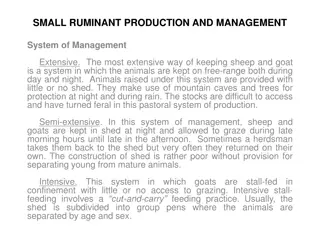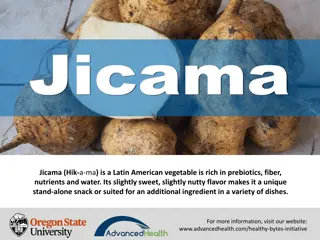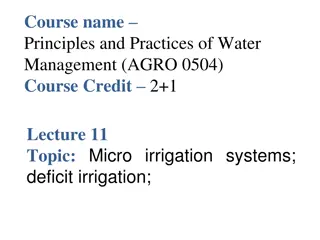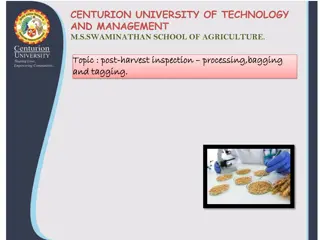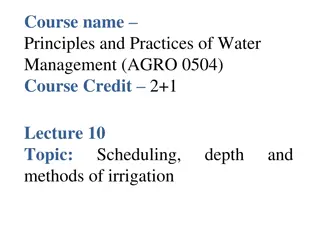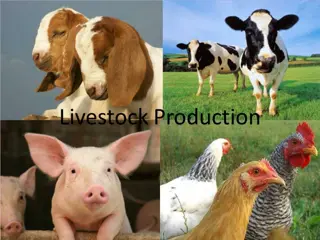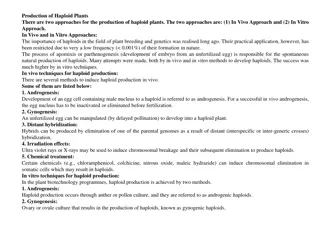Production Technology of Underutilized Vegetable Crops: Kale and Collards Overview
Explore the production technology and characteristics of underutilized vegetable crops Kale and Collards, including their origins, types, and growth habits. Learn about their nutritional value, cultivation, and unique features that make them ideal additions to kitchen gardens.
Download Presentation

Please find below an Image/Link to download the presentation.
The content on the website is provided AS IS for your information and personal use only. It may not be sold, licensed, or shared on other websites without obtaining consent from the author. Download presentation by click this link. If you encounter any issues during the download, it is possible that the publisher has removed the file from their server.
E N D
Presentation Transcript
PRODUCTION TECHNOLOGY OF UNDERUTILIZED VEGETABLE CROPS HVSC 0509 (2+1) Dr. THRIVENI VANGAPANDU Assistant Professor (Horticulture) MSSSoA, CUTM
PRODUCTION TECHNOLOGY OF KALE & COLLARDS Introduction Botanical Name: Brassica oleracea var.acephala D.C Brassica oleracea var Viridis Family: Brassicaceae Chromosome No.: 2n=18 (n=9) Mode of pollination: Crosspollinated Edible parts : Leaves Among cole crops Kale and collards are rare grown in kitchen gardens of Kashmir Both kale and collards are used in raw or cooked form like other leafy greens. Kale is Scottish word derived from coles or caulis , term used by the Greeks & Romans referring to the cabbage group like plants. Kale & collards differ in appearance but have more resemblance with wild cabbage- Coldwarts than any of its other cultivated forms. Kale is crowned as queen of greens because it has highest in Vitamin-A(9990 IU/100g) and Vitamin C187mg/100g edible portion) among the all crucifers. It has good source of lutein and anticarcinogenic compounds-particularly contains indoles- regulate estrogen &inhibits colon cancer. - Kale - Collards
Origin Its center of origin is Mediterranean region. Kale & collards differ in appearance but have more resemblance cabbage-Cold warts- Brassica oleracea var. sylvestris than any of its other cultivated forms. In the 1600s kale made its way through Europe to the United states. However its introduced in India during 19th century. with wild
Continued Types of kales 1.Curly kale :B.O. sub. Laciniata : Kales having finely curled foliage Its mainly grown for consumption and also one of the earliest form of cole crops. 2.Smooth leafed kale :B.O. Sub. var. plana 3.Thousand headed kale: B. O. Sub. var. millecapidata (Sprouted axillary buds forming loose leafy rosette. 4.Tree kale: B.O. sub var. palmifolia Tree kales having height upto 2m. 5.Marrow stem kale : B.O. Sub var. medullosa :These kales having long swollen stems. Chinese kale: Brassica alboglabra Other types kales are used for fodder, live stock and for ornamental purpose Collards: B.O. var. viridis : it is an intermediate form of non heading and heading cabbages and resembles to all kales in growth habit with smooth leaf blades than the crinkled leaf blades. It is also known as tree cabbage/ non headed cabbage and flavour of stem and leaves is milder than the kales
Continued Types of kales Karam sag of Kashmir as kale is closely related to Chinese kale because these are freely intercrossed with each other. Both Chinese kale and karam sag requires different temperature regiems but rossete of leaves at the top & tender leaves are edible portion in the both the crops. Chinese kales are white and retain their edibility upto bolting stage. Kale Collards B.O.Sub.achephala B.O.Sub.viridis Growth habit: open type Upright growth Appearance: terminal portion ending with rosette of leaves i.e. non heading intermediate form between heading and non heading cabbages(Transitional type of cabbage) Terminal portion ending with loose heads of cabbage like mild flavour leaves Plant is dwarf (20-30cm)- tall (180cm in thousand headed kale) Intermediate in size (90-100cm)between dwarf &tall kales The stem tough coarse but nether branched nor markedly thickened The stem is unbranched, thick and stiff Leaves are curled, smooth and high variability in size, height, colour and forms of leaves Leaves are smooth with less variability occurs. Winter hardy and plants are not killed even in the severe winter Besides being winter hardy, it can tolerate more heat than kale
Marrow stem kale Thousand headed kale: B.O.sub.millecapidata Curly kale: B.O.sub. laciniata Smooth leafed kale Brassica alboglabra- Chinese kale Collards: B.O.var. viridis Tree kale
Continued Types of kales Branching bush kale: B.o. var fruiticosa also known as cow kale- for its edible foliage & extensively used for animal fodder. Kale Varieties: Delaway: it requires 60-65 days to first harvest. Features- good flavour, very attractive in nature producing long green leaves with purple tinge. Lark s Tounge: it s a German kale variety actually called Lerchenzungen . Its take 55 days to mature and very hardy in nature, 2-3ft height, slender, elongated and slightly ruffled leaves. Red Russian: 55 days to mature having purple vein and deep lobbed leaves. It is tender and sweet even in summer.it can be harvested throughout the season if it is planted in spring. Red Ursa, Redbore, Starbor, Tall scotch, Dwarf Siberian, Darkibor Ripbor Scarlet Siberian Toscano/lacinato Vates Blue Dwarf it is ready for harvest 30DAP Collards varieties: Champion, Georgia, Vates, Flash Hybrid
Soil & climate requirements Soil requirements: Both the collards and kale can be grown on wide range of soils viz. sandy lams to clay loams. However soil must be fertile, well drained with good water holding capacity. The ideal soil reaction pH is between 6-7.5. Climate requirements: It is hardiest crop among brassicas capable of with stand temperature as -15 C with better tolerance to high summer temperatures. These are cool season vegetables and they can be grown in the temperature range of 12-18 C. Chinese kale (Brassica alboglabra) requires comparatively high temperature around 18-20 C. In this crops frost improves the edible quality of the leaves. The collards are hardy to low as well as high temperatures than kale. Rain fall about 30-500mm is best for optimum yield of kale.
Production technology Mode of propagation : seed Season of planting: Summer crop-sowing (march-April) Early summer-September-October- transplanting(Oct-November) In hills: August-September Depth of sowing:1-1.25cm with spacing 45-60cm(between rows) x 45cm(with in rows) Dwarf varieties: 60 x60cm, 60 x 45cm Medium varieties: 75 x 60cm, 75 x 45 cm Tall varieties: 90 x 60cm Nursery bed size: 1m width with convenient length is made followed by drenching of soil with mixture of fungicide Loyalty 10g+ Pyrimid 700 WP 100g insecticide+ sticker(20ml)/20L of water to minimize pest and diseases, to break dormancy to facilitate uniform germination of seeds. Seed rate: dwarf varieties: 500-750g/ha Medium: 400-500g/ha and tall varieties: 350-400g/ha.
Manures & fertilizers requirements Both the crops are heavy feeders. For average fertile soils 15-20 t/ha FYM- final land preparation Inorganics Dosage : N-100-150kg/ha P-50-80kg/ha K-50-80 kg/ha Full P O ,K O and 1/3rd N are mixed and applied as basal dose. Rest N is applied in two equal splits :30 and 60 DAT as top dressing. Intercultural operations Early stages weeding should be managed. 1 or 2 hand weeding's followed by hoeing effectively controls weed population.
Harvesting and yield Kale harvested in two ways A) entire plant is cut off at ground level about 40 DAT B) or the lower leaves are periodically picked. The inner leaves and buds are left to produce new leaves The leaves are harvested before they become old /mature, tough and stringy. In collards all green parts of the plants are edible and may be harvested at any time during growing season after attaining 25-30 cm height. Yield: Average yield potential: 150-200q/ha Post harvest management: Both kale and collards greens may be stored in dry plastic bags in the refrigerator for up to 3 days. They may be stored in the freezer in sealed plastic bags for the month. On commercial scale, collards and kale are stored close to 0 C with RH of at least 95%. shelf life held for 10-14 days.


